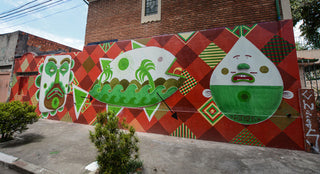Bold colors, often greens and reds, and intricate patterns—pulled from kites, balloons, woven baskets, or ornate Portuguese tiles—are hallmarks of Brazilian artist Raphael Sagarra aka Finok. But the people of Brazil, a diverse population with unique customs and traditions, are the cornerstone. “I love the diversity we have here,” Finok says. “If Brazil is a multiracial country, then São Paulo is the epicenter of culture, race, and everything.” In his murals and paintings, costumed characters sing, dance, and pray as the artist blends Brazilian folk culture with his own unique vision.
But Finok is careful to separate his work on the streets from his work for galleries—the former is about observation and the latter is about examination and conclusion. “For me, the streets are perfect to paint and to observe how the peoples’ lives are here,” he explains. “Those observations make me question myself and the issues we have here, and that’s when the art starts.” Finok started his career as a graffiti writer—as part of the VLOK crew with fellow art stars Os Gemeos and Nunca—and has since gone on to show his work in galleries around the world. He has had recent shows at Ruttkowski in Cologne, Patricia Armocida in Milan, and Jonathan LeVine in New York, and in the following interview, he discusses graffiti, his career, and how his artwork depicts life in Brazil.

When and where did you first discover graffiti? How old were you? What did you think about?
When I was younger—about 14 or 15 years old—I saw some guys painting in the neighborhood I grew up in. It was a shock of information, and there were lot of questions in my head. So, knowing nothing, I began to search for the answers and started to paint. I’ve learned in the best way, by doing a lot of wrong things. In that time in São Paulo, all the writers and artists had their own styles with colors, characters, abstract paintings, latex pieces, and throw-ups, and were searching for new things. The difference between here and other parts of the world is how we have to deal with graffiti’s obstacles. In other parts of the world, painting graffiti without permission is crime, here in Brazil, sometimes it’s not.
I’ve learned in the best way, by doing a lot of wrong things.
Can you talk a little bit more about the different obstacles? How do people in Brazil perceive graffiti? For example, you said it’s not always illegal… but are you talking about murals? I would assume the public generally dislikes something less colorful, like pixação...
In Brazil, we have the possibility to talk to the police, so when we are doing something illegal, we need to make it look legal. Sometimes the authorities know that we are painting illegally, but this city has so many problems that graffiti is a superficial problem, it’s only paint. Some people like graffiti, others don’t. But graffiti in São Paulo has become an epidemic, so many people painting everywhere.


When and why did you start painting on canvases and making work for galleries?
I started in a very natural form. I always drew, so in between the pieces, I was sketching something different from what I was doing on the streets. Canvases were the perfect platform to paint the drawings, and it was a completely different medium from what I was used to.
For me, the streets are perfect to paint and to observe how the peoples’ lives are here. Those observations make me question myself and the issues we have here, and that’s when the art starts.
How does your artwork illustrate life in Brazil?
Brazil is one of the most mixed-race countries in the world. The mix is part of our lives, not just in a racial way, but also in all the possible forms. We are a people who mix whatever it takes to get something done. In my work, not only in the colors and patterns, everything is connected with Brazil. The kites and balloons I paint are an example of that—the Brazilians didn’t invent them, but changed and made them their own. What I most like about Brazilian kites and balloons is how ephemeral they are. It’s hard work that we put into making them, but then in one minute, you don’t have them anymore.
[Brazilians] are a people who mix whatever it takes to get something done.”

In a lot of my interviews, artists talk about growing up in the 1980s or 1990s and how these decades influenced them—particularly the books, movies, music videos, and graphics of these decades. What TV shows or movies or videos did you grow up watching and loving in Brazil that maybe we don’t know about here? Was there any sort of design that influenced you from this era?
For me, everything is always inspiring me, even things older than me. There is a lot that influenced me, for graffiti style for sure the old cartoons. They are so simple, but with so much style on it. Brazilian music from the ’70s or ’80s is still inspiring me—the lyrics, and everything about it. Growing up in the streets with a lot of kids and friends around me is something that influenced me as well—not in a visual way, but in the contact with people, learning how to deal, to observe, and the values of the life.
What do you want people to understand or think about when looking at your work?
I just want people to think about it, sometimes it’s not necessary to understand. That’s what art is about, it should make you think, makes you feel something.
What are you working on now? What’s next for you?
I’m working on my next solo show in London, and some parallel projects.

***

